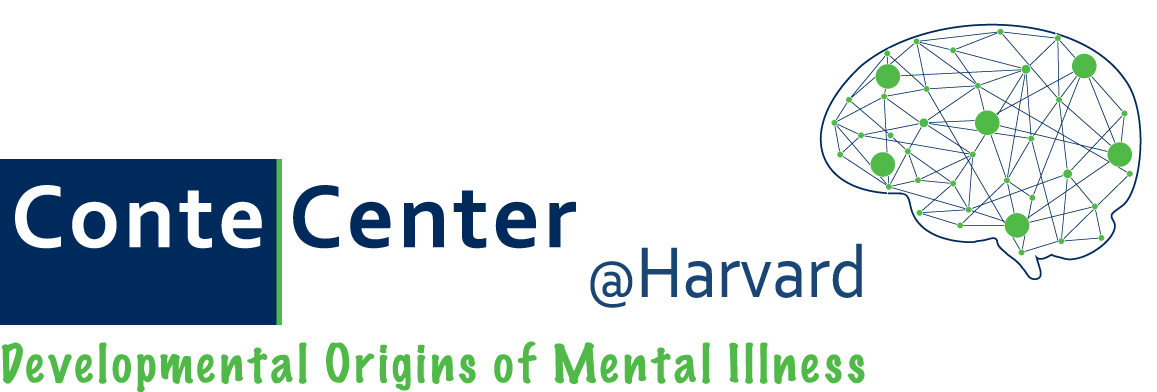Probing how a rise in inhibition might trigger critical periods
The model in this study zooms in on a single pyramidal neuron in visual cortex, receiving excitatory inputs from both the contralateral (opposite side) and ipsilateral (same side) eyes. The “y” represents the firing rate, or output of this neuron, and “m” is the combined strength of inhibitory inputs from neighboring cortical neurons. The hypothesis is that maturation of inhibition “turns” on the critical period for ocular dominance plasticity. The authors of this study propose that as inhibition matures, it increases the influence of visually-evoked, as opposed to spontaneous, neural activity >>
Model of visual critical period suggests that maturation of inhibition in early postnatal development lowers the ratio of spontaneous to evoked cortical activity
by Parizad M. Bilimoria
Inhibitory circuits in the cerebral cortex are known to mature subsequent to excitatory circuits, and this later maturation of inhibition is believed to play a central role in triggering critical periods. Yet exactly how the rise of inhibition “turns on” a critical period has long remained enigmatic.
In a Viewpoint article published October 2nd in Neuron, researchers propose that the answer lies in the selective suppression of spontaneous, as opposed to environmentally-evoked, neural activity. Critical period plasticity may be induced when there is a shift from predominantly internal to predominantly external learning cues, and the ratio of spontaneous to evoked cortical activity is lowered past a certain threshold. This theory differs from past proposals in that it takes into account the existence of experience-dependent plasticity before the onset of a critical period, and suggests that while the outcome of experience-dependent plasticity changes when a critical period is triggered, the cellular and molecular mechanisms of plasticity do not necessarily have to change.
The researchers, led by senior authors Takao K. Hensch, professor in the Department of Molecular and Cellular Biology and director of the Conte Center at Harvard University, and Kenneth D. Miller, professor in the Department of Neuroscience at Columbia University, focused on the critical period for ocular dominance plasticity in mice, currently one of the best understood critical periods in animal models. Ocular dominance plasticity is a phenomenon in which shutting one eye (monocular deprivation) during the critical period—but not before or after—leads to a shift in cortical responsiveness towards the open eye, accompanied by decreased acuity in the visually-deprived eye.
The idea that the onset of the critical period for ocular dominance is marked by a change in the relative influence of internal vs. external learning cues came from the observation that spontaneous neural activity is generally equal between the two eyes of an animal, whether they are open or not—while visually-evoked activity is definitely unequal during monocular deprivation. This would suggest that visually-evoked activity is what drives the critical period. As long as spontaneous activity overpowers visually-evoked activity, monocular deprivation would not be able to induce the sort of plasticity it does during the critical period.
To test their theory, the team, with first author Taro Toyoizumi, currently heading the Lab for Neural Computation and Adaptation at the RIKEN Brain Science Institute in Japan, first designed a computational model centered on the workings of a single pyramidal neuron in the visual cortex receiving inputs from both eyes. They described the transition into the critical period for ocular dominance mathematically as a change in the strength of inhibition coming from neighboring cortical neurons. This change, in an equation describing the output of the pyramidal neuron, effectively reduces its spontaneous activity relative to activity evoked by visual inputs. Running simulations of pre-critical period and critical period times on this computational model recapitulated what previous biological studies had revealed about the differential impact of monocular deprivation on ocular dominance, but not retinotopic refinement, during these times.
The team then conducted experiments in freely-behaving adult mice to test the main prediction of their theory: the spontaneous to evoked activity ratio in a pyramidal neuron of the visual cortex is a physiological correlate of ocular dominance plasticity. Using mutant mice deficient in the inhibitory neurotransmitter GABA as well as a drug that enhances GABA activity to model different states of ocular dominance plasticity (pre-critical period, post-critical period, and “open” critical period) together with flashing LED lights as visual inputs, Hiroyuki Miyamoto performed tetrode recordings and found that indeed a lower spontaneous to visual activity ratio is present when the critical period is “open.” (In this case the “open” critical period state of juveniles was mimicked in adults by a combination of the genetic and pharmacological manipulations.)
In future studies it will be important to examine the ratio of spontaneous to evoked activity in cortical neurons during other critical periods—from those for other basic sensory functions such as hearing and touch to those defining higher order cognitive and social behaviors.
Beyond its relevance to a basic science understanding of critical periods, this newly put forth theory as to how inhibition triggers critical period plasticity also opens up new lines of investigation for autism and schizophrenia. Both of these disorders are marked by inhibitory neuron pathology, and Hensch and others have hypothesized that cascades of critical periods are disrupted. Since internal and external realities may be confounded in mental disorder (for instance, in schizophrenia, when people hear voices that are not externally present), this theory naturally leads to questions about the balance of spontaneous versus environmentally-evoked cortical activity in these disorders—and ultimately, how interventions might be designed and timed to correct imbalances correlating with symptoms.
For more information:
A Theory of the Transition to Critical Period Plasticity: Inhibition Selectively Suppresses Spontaneous Activity
Full text of the scientific article in Neuron
Windows of plasticity in brain development: What’s a neuron gotta do to open one?
E/I Balance blog post about Neuron article

